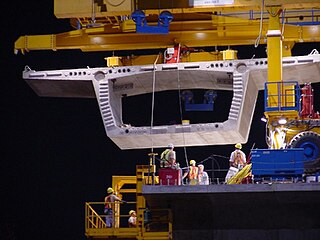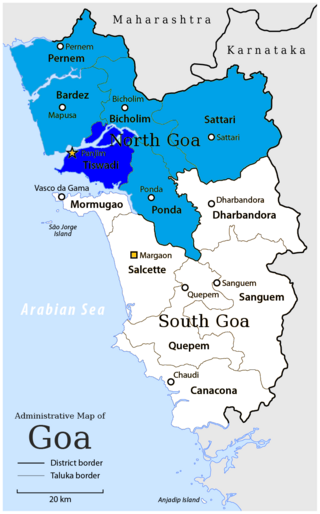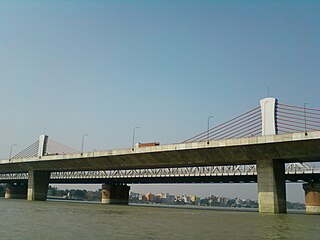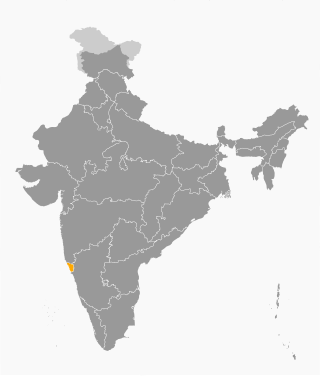
Panaji is the capital of the Indian state of Goa and the headquarters of North Goa district. Previously, it was the territorial capital of the former Portuguese India. It lies on the banks of the Mandovi river estuary in the Tiswadi sub-district (taluka). With a population of 114,759 in the metropolitan area, Panaji is Goa's largest urban agglomeration, ahead of Margao and Mormugao.

The Mandovi or Mahadayi, formerly known as the Rio de Goa, is a river described as the lifeline of the Indian state of Goa. The Mandovi and the Zuari are the two principal rivers in the state of Goa. The Mandovi joins the Zuari at a common creek at Cabo Aguada, forming the Mormugao harbour. Panaji, the state capital and Old Goa, the former capital of Goa, are both situated on the left bank of the Mandovi.
Mahatma Gandhi Setu is a bridge over the river Ganga in Bihar, India, connecting Patna in the south to Hajipur in the north. Its length of 5,750 metres (18,860 ft) makes it the fourth-longest river bridge in India. It was inaugurated in May 1982 in a ceremony in Hajipur by the then-prime minister Indira Gandhi. From 1982 to 2017, Mahatma Gandhi Setu remained the longest bridge in India. Later, the Gandhi Setu rehabilitation project was undertaken to install triangular steel trusses on Mahatma Gandhi Setu.

A segmental bridge is a bridge built in short sections, i.e., one piece at a time, as opposed to traditional methods that build a bridge in very large sections. The bridge is made of concrete that is either cast-in-place or precast concrete.

The Ponte Conde de Linhares, often shortened to Ponte de Linhares is a 3.2 km (2.0 mi) long causeway connecting Ribandar to the main city of Panjim in Goa, India. It runs along the flood plains of the Mandovi River and is surrounded by various salt pans. There are ducts which act as tide controls. The Ponte Conde de Linhares was built in 1633–34 under the direction of the then Viceroy of Portuguese India, Miguel de Noronha, 4th Count of Linhares, after whom it is named. The bridge is often said to have been the longest in the world at 3.2 km (2.0 mi) when it was completed in 1634.
This is a timeline of Goan history. It overlaps with the histories of other regions in South Asia, the Indian subcontinent, and colonial powers that influenced the region, including Portugal.

Tiswadi, formerly known as Ilhas, is a taluka in the district of North Goa, situated in the Indian coastal state of Goa. It is an estuarine island situated on the confluence of the Mandovi and Zuari rivers. It was one of the first territories to be annexed by the Portuguese in the 16th century. Both the state capital Panaji, and the erstwhile capital Old Goa lie within the sub-district. It is the biggest and the most populated of the six major islands between the Mandovi and Zuari rivers.

Nivedita Setu is a multi-span extradosed bridge spanning the Hooghly River, connecting Bally, Howrah with Dakshineswar, Kolkata. It runs parallel to and about 50m downstream of the old Vivekananda Setu, opened in 1932. The bridge is named after Sister Nivedita, the social worker-disciple of Swami Vivekananda. The bridge is one of only five roadway bridges crossing the Hooghly River within the Kolkata metropolitan region. Belghoria Expressway which connects the meeting point of NH-16 with NH-19 at Dankuni to NH 12, Kalyani Expressway, Kolkata Airport and northern parts of Kolkata passes over the bridge. The bridge is designed to carry 48,000 vehicles per day.

Vidyasagar Setu, also known as the Second Hooghly Bridge, is an 822.96-metre-long (2,700 ft) cable-stayed six-laned toll bridge over the Hooghly River in West Bengal, India, linking the cities of Kolkata and Howrah. Opened in 1992, Vidyasagar Setu was the first and longest cable-stayed bridge in India at the time of its inauguration. It was the second bridge to be built across the Hooghly River in Kolkata metropolitan region and was named after the education reformer Pandit Ishwar Chandra Vidyasagar. The project had a cost of ₹388 crore to build. The project was a joint effort between the public and private sectors, under the control of the Hooghly River Bridge Commissioners (HRBC).

The Zuari Bridge is a bridge between North Goa and South Goa, India. It carries the NH 66 over the tidal part of the Zuari River, between the villages of Agaçaim and Cortalim. It is a few metres downstream of the Konkan Railway Bridge.

Goa is a state on the southwestern coast of India within the Konkan region, geographically separated from the Deccan highlands by the Western Ghats. It is bound by the Indian states of Maharashtra to the north, and Karnataka to the east and south, with the Arabian Sea in the west. It is India's smallest state by area and fourth-smallest by population. Goa has the highest GDP per capita among all Indian states, two and a half times as high as the GDP per capita of the country as a whole. The Eleventh Finance Commission of India named Goa the best-placed state because of its infrastructure, and India's National Commission on Population rated it as having the best quality of life in India. It is the second-highest ranking among Indian states in the human development index.
The state of Bihar has a number of bridges, extending from few metres to a few kilometres. The history of long bridges goes back to the British Empire when the site for the Koilwar bridge was surveyed in 1851. Since then a number of small and large bridges have crept up. Some are even largest of their kind. Mahatma Gandhi Setu, joining Patna and Hajipur was India's longest river bridge from 1982 to 2017.

Arrah–Chhapra Bridge is the longest multi-span extradosed bridge in the world with a main bridge length of 1,920 m (6,300 ft). The bridge crosses over the Ganges River in India, connecting Arrah in Bhojpur district to Chhapra in Saran district of Bihar state. The bridge provides a roadway link between the northern and southern parts of Bihar. The bridge opened for public use on 11 June 2017.
The Kacchi Dargah–Bidupur Bridge, currently under construction, will span the river Ganges, connecting Kacchi Dargah in Patna and Bidupur in Hajipur in the Indian state of Bihar. Upon completion in 2025, the bridge will provide an easy roadway link between the northern and southern parts of Bihar and will connect two major national highways, linking NH 31 to NH 322.

The following outline is provided as an overview of and topical guide to Goa:

The Atal Setu is a cable-stayed bridge in Goa that runs between Panaji and Porvorim. It carries National Highway 66 over the tidal part of the Mandovi River. It is 5.1 kilometres (3.2 mi) long, making it the third longest cable-stayed bridge in India. Two wheelers, three wheelers and bullock carts are prohibited from using the Atal Setu due to its height of 30 metres (98 ft). It officially opened on 5 February 2019.

Cable Bridge, Surat or Pandit Dindayal Upadhyay Bridge is a cable-stayed bridge over the Tapti River that connects the Athwa and Adajan areas of Surat, Gujarat, India. The bridge is named after Indian politician and thinker Deendayal Upadhyaya. A connected 3-way interchange flyover bridge was constructed on the Athwalines side to facilitate easy flow of the traffic.
The Sudarshan Setu is a cable-stayed bridge in India, connecting the Beyt Dwarka island in the Gulf of Kutch and Okha. The total length of the bridge is 2,320 metres (7,612 ft). It was inaugurated on 25 February 2024.
New Zuari Bridge, also commonly known as Manohar Setu, is a bridge over the Zuari River in Goa, India, linking the districts of North Goa and South Goa.
















